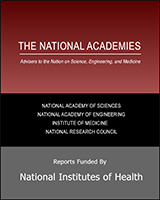NCBI Bookshelf. A service of the National Library of Medicine, National Institutes of Health.
National Research Council (US) Committee for the Update of the Guide for the Care and Use of Laboratory Animals. Guide for the Care and Use of Laboratory Animals. 8th edition. Washington (DC): National Academies Press (US); 2011.

Guide for the Care and Use of Laboratory Animals. 8th edition.
Show detailsThis eighth edition of the Guide is divided into five chapters and four appendices.
Chapter 1 presents the goals and intended audiences of the Guide as well as key concepts and terminology essential to its premise and use. Incorporating some of the material from the Introduction to the last edition, the chapter highlights a commitment to the concepts of the Three Rs—Replacement, Reduction, and Refinement—and provides an enhanced discussion of the ethics of animal use and investigator/institutional obligations.
Chapter 2 focuses on the overall institutional animal care and use program (Program), in addition to many of the topics previously covered in Chapter 1 of the seventh edition. It defines the evolved concept of Program and provides a framework for its intra-institutional integration, taking into account institutional policies and responsibilities, regulatory considerations, Program and personnel management (including training and occupational health and safety), and Program oversight. Discussions of the latter include institutional animal care and use committee (IACUC) functions, protocol and Program review, postapproval monitoring (a new section), and considerations such as humane endpoints and multiple survival surgical procedures. The Committee endorses the American College of Laboratory Animal Medicine’s “Guidelines for Adequate Veterinary Care.”
Chapter 3 focuses on the animals themselves and, unlike previous editions, addresses terrestrial and aquatic species in separate sections, reflecting the growing role of aquatic animals in biomedical research. The chapter provides recommendations for housing and environment, discusses the importance of social housing, and includes enhanced sections on environmental enrichment, animal well-being, and scientific validity.
Space recommendations were nominally expanded based on the Committee’s professional and expert opinion and on current housing methods. Cage sizes have historically been interpreted as minimum space needs by users of the Guide, and were labeled as such (“recommended minimum space”) in this edition. The use of the word “minimum” does not further restrict users of the Guide because, although the space requirements are numbers (i.e., engineering standards), they are used in a performance standards framework. The Committee recommends minimum space for female rodents with litter and an increase of the cage height for rabbits to 16”. Further, in light of many comments submitted to the Committee requesting more information on performance goals and how to achieve them, rodent breeding recommendations are accompanied by substantial guidance.
With respect to nonhuman primates (NHPs), the Committee endorses social housing as the default and has provided some species-specific guidance. An additional group has been added for monkeys, and chimpanzees are separated in a new category. These changes were motivated by the Committee’s recognition (affirmed in comments solicited from NHP experts) that these animals need more floor and vertical space, at least in some groups, to exercise their natural habits.
Chapter 4 discusses veterinary care and the responsibilities of the attending veterinarian. It introduces the concept of animal biosecurity and upholds its central role in ensuring the health of laboratory animals. The chapter includes recommendations relative to animal procurement, transportation, and preventive medicine, and expands the sections on clinical care and management, surgery (with a new section on intraoperative monitoring), pain and distress, and euthanasia.
Chapter 5 discusses physical plant–related topics and includes updated and new material on vibration control; physical security and access control; hazardous agent containment; and special facilities for imaging and whole body irradiation, barrier housing, behavioral studies, and aquatic species housing. The chapter provides detailed discussion of centralized versus decentralized animal facilities and introduces the concept of variable-volume HVAC systems with a nod toward energy conservation and efficiency.
Appendix A is the updated bibliography; Appendix B presents the U.S. Government Principles for the Utilization and Care of Vertebrate Animals Used in Testing, Research, and Training; Appendix C presents the Statement of Task; and Appendix D provides the biographical sketches of the Committee members.
In accordance with the Statement of Task (“In addition to the published report, the updated Guide will be posted on the Internet in a pdf or equivalent format such that users will be able to search the entire document at one time”), the Guide is available in searchable pdf format on the National Academies Press website, www.nap.edu.
- Overview - Guide for the Care and Use of Laboratory AnimalsOverview - Guide for the Care and Use of Laboratory Animals
Your browsing activity is empty.
Activity recording is turned off.
See more...